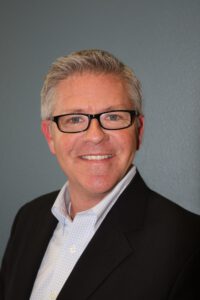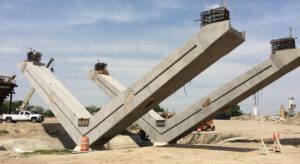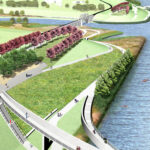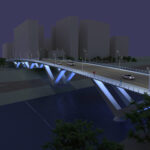The Trinity River has been an invaluable asset to Fort Worth, Texas, since its founding in 1849. As the city expanded, efforts were made to construct levees and safety features along the river to provide protection during high-water events. Recently, however, Fort Worth has outgrown the existing levee system’s area of protection.
Recognizing the problem, the project partners, the citizens of Fort Worth, and businesses began pursuing a project to ensure the safety of their community while establishing a new mixed-use and entertainment district. The Trinity River Vision Authority (TRVA) organized in 2006 as a group of stakeholders from local governments and regional water authorities to bring that project to fruition.
Municipal Water Leader’s senior writer, John Crotty, spoke with TRVA Executive Director J.D. Granger about the efforts to ensure public safety and provide Fort Worth with a refreshed business district.

John Crotty: What are the major flood control components of the Trinity River Vision?
J.D. Granger: The Trinity River Vision plan is a plan to address our outdated levees. Our levee system was built for a population of 350,000 in 1960. However, the population has outgrown the system. Now we have a population of around 900,000 people, and the levees cannot adequately protect our population.
When we started to plan this project, we took a global look at this problem. We first explored making our levees bigger. Then, we looked at figuring out a way to create a system that will foster an economic development opportunity to help pay for it. Deciding to only make our levees bigger would have made us safer in the short term, but it would have been a temporary patch because we only have so much capacity to begin with.
Instead, we decided to pursue a long-term plan. We decided to make ourselves safer and create growth opportunities for our city. To do so, we are rerouting our river to provide safety for about 2,400 acres of existing neighborhoods.
In addition to providing safety, this action will also create viable growth opportunities to pay for our project. It will create opportunities for a bigger tax base that will help us pay off our local share of the project. In a sense, it is a self-funding mechanism. Without this approach, it would have been really hard to put funding together for this project. Additionally, it will create a new identity for our city. The new central business district will be laced with river walks and have a beautiful lake.
John Crotty: What role is the U.S. Army Corps of Engineers playing in the development of the project’s flood control infrastructure?
J.D. Granger: Our river touches every single neighborhood like the spokes of a wheel. The community wanted access to the river and for it to be an integral part of our community, much like in San Antonio. The Army Corps greatly respected the community’s wish.
From there, we decided to do two things. One was to figure out a solution for a flood event. The other was to do it in a way that provides new opportunity for our community.
I can’t stress enough how important it is to understand your partner’s mission statement. The Army Corps is not in the business of providing economic development. So, we devised a plan that delivers everything the Army Corps requires, such as safety, as well as growth for Fort Worth, knowing that we would pay for any work that was additional to the safety component. The Army Corps understood our request and encouraged us to work with it to provide a stronger system.
John Crotty: How does the TRVA interface with the Army Corps on the project?
J.D. Granger: The Army Corps has designed and constructed all the current system components and is designing and constructing all the new components as well. For this project, TRVA has had to work with local partners to secure the property that the Army Corps can use for the flood control system. This includes relocating any businesses that may be affected, moving utilities out of the way, and acquiring property. Once this is complete, the Army Corps will construct the system. Essentially, the Army Corps is doing all the bricks and mortar, and we are doing all the upfront preparation work.
All projects are not going to be done by one agency alone. You are always going to have to partner at the state, local, and federal level. To alleviate some of the interfacing problems, we maintain the schedule and cost estimating for all our partners.

Additionally, we handle the interaction between the Army Corps and any other local agency. I think that is very critical. The Army Corps speaks a very specific language, and it is easy to understand if you take the time to learn it. The Army Corps can only communicate in a very specific way, so it is hard for it to interface separately with all those other entities.
TRVA volunteered to put our entire local program into the Army Corps’ language. We brought in three schedulers, and once we learned to talk the Army Corps’ language, things started to work better. If you can stay within the Corps’ constraints, you can do a lot; but, if you ask the Corps to do something it cannot do, you have to respect its limitations.
John Crotty: What is the nexus between the flood control aspects of the Trinity River Vision and the economic and recreational development of Panther Island?
J.D. Granger: There are three main things the Army Corps is doing on the project: rerouting the Trinity River in Fort Worth, installing a series of floodgates, and increasing storage. All three are major flood control additions. Rerouting the river takes a kink out of our system that typically backs up water due to its sharp angle. The floodgates protect a low-lying area in our city. And the storage provides more opportunity to effectively manage water in a high-water event.
On the economic development side of things, the river reroute provides an opportunity to have a riverfront business district. Once this project is complete, we will have put in 11 miles of river walks throughout the city. The floodgates allow us to have more of a business district in the low-lying areas. The storage creates perfect environments for parks all around the city.
John Crotty: Please describe the current conditions of the area to be developed. What will a fully realized vision of that area mean for the city?
J.D. Granger: Right now, the area we want to develop is a low-lying industrial area with significant environmental issues. From it, we are going to create an energetic, high-density, mixed-use district that will allow our residents and visitors to fully embrace an outdoor lifestyle in Fort Worth.

John Crotty: In your experience, what is the one critical step that others should take to make a project like this come to fruition?
J.D. Granger: Respect your partners’ primary mission and understand the limitation of each partner.
The next thing is tough to accept, but you have to enjoy the base hit. I see many cities with an aggressive approach to projects. They swing for the fences at the beginning, before they work out the mechanics of the project. It is important to understand and accept that there are some challenges. You do not have to solve all of them at one time.
The third thing is to respect your partner. Do not fight in public. When you fight in public, you strip away any opportunity for creativity. Great and smart people can be creative when others are not scrutinizing them.
Don’t be a person that identifies problems, be the person who identifies problems and offers solutions. If you can do that, the public will support and respect you. Such an approach will foster the public’s understanding of costs that may exceed initial expectations.



